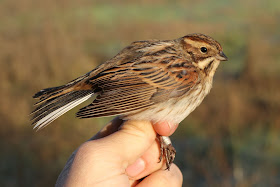Certainly, the blog has been a bit abandoned for some time. I'll do my best to bring it back to life, or at least a bit more often than what it has been for the last year....
So, to start with again, some things from the last few days.
As I've been doing for the last five winters, the Reed Bunting (Emberiza schoeniclus) roosting project is still alive. Time has given a lot of perspective to the results, that start indicating some things.
 |
| Adult (EURING 6) males are starting to look really handsome! |
 |
| Number of captures by age/sex and date, comparing the winters of 2017/18 and 2018/19. The bottom chart is intentionally moved to the right, to 'make it fit' at the same timeline. Note that I don't have data of October for the current winter, and that I stopped going to the site on 2017/18 because of very few wintering birds! |
One interesting thing to look at is the difference in sex-ratio. Just comparing this season with the previous one, this year it has definitely many more males than the previous. Last winter (2017/18) was very poor with wintering individuals in the area, but there were some very good days of migration (mostly females). This season, I have no data from October, but when I started in November the proportion of males was already higher than the previous year, and it has kept like this so far. Note that even some days males were more common than females! The reason? I don't know for sure.
This year has provided 5 foreign recoveries so far: 3 from France, 1 from Sweden and 1 from Switzerland (the latter is currently wintering at one of the sites).
 |
| A first-year (EURING 3) female from Sweden, caught during December. Sadly not a Falsterbo bird, but still it will be quite exciting to know where it comes from - Sweden is so large! |
 |
| Another first-winter (EURING 3/5) female, this one from Switzerland. The first recovery from this country on this project! |
But maybe, the best bird so far has been this first-winter, which is a truly rare case of 3 outer greater coverts unmoulted!


No comments:
Post a Comment